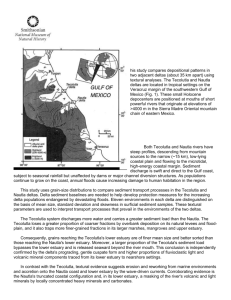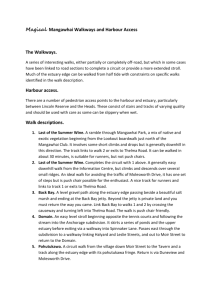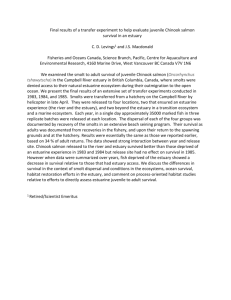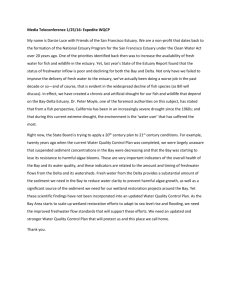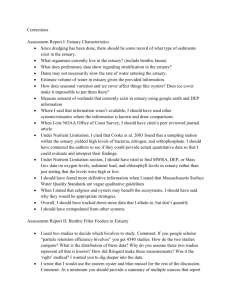Analysis on Impact of the Coriolis Forces on Flow in the Yangtze
advertisement
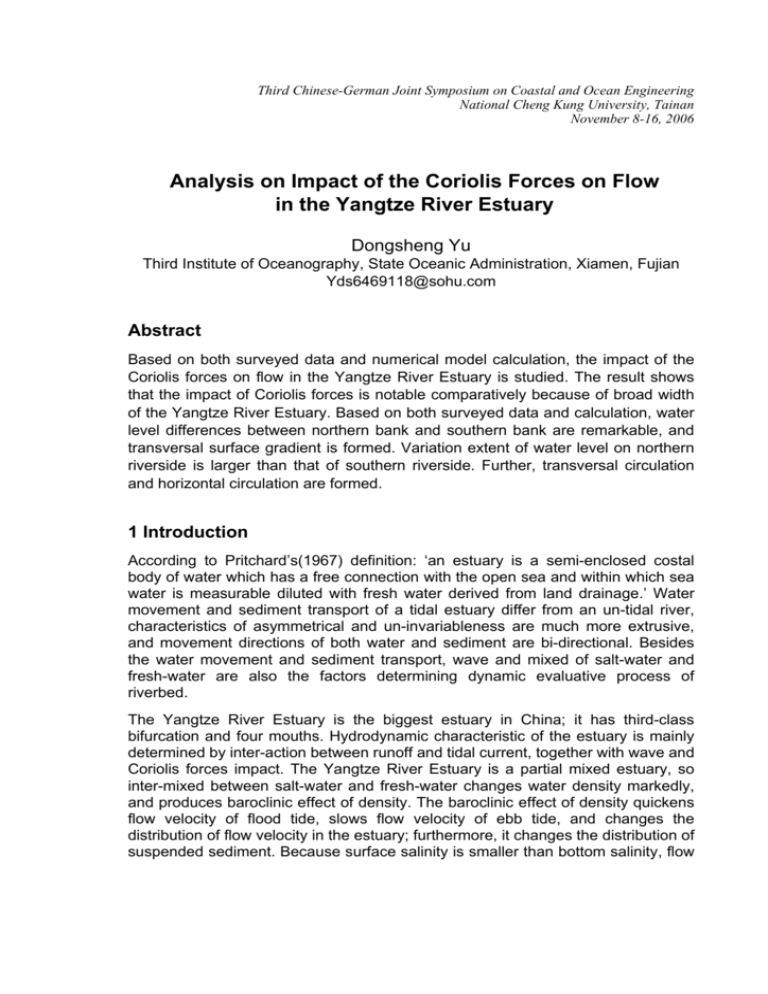
Third Chinese-German Joint Symposium on Coastal and Ocean Engineering National Cheng Kung University, Tainan November 8-16, 2006 Analysis on Impact of the Coriolis Forces on Flow in the Yangtze River Estuary Dongsheng Yu Third Institute of Oceanography, State Oceanic Administration, Xiamen, Fujian Yds6469118@sohu.com Abstract Based on both surveyed data and numerical model calculation, the impact of the Coriolis forces on flow in the Yangtze River Estuary is studied. The result shows that the impact of Coriolis forces is notable comparatively because of broad width of the Yangtze River Estuary. Based on both surveyed data and calculation, water level differences between northern bank and southern bank are remarkable, and transversal surface gradient is formed. Variation extent of water level on northern riverside is larger than that of southern riverside. Further, transversal circulation and horizontal circulation are formed. 1 Introduction According to Pritchard’s(1967) definition: ‘an estuary is a semi-enclosed costal body of water which has a free connection with the open sea and within which sea water is measurable diluted with fresh water derived from land drainage.’ Water movement and sediment transport of a tidal estuary differ from an un-tidal river, characteristics of asymmetrical and un-invariableness are much more extrusive, and movement directions of both water and sediment are bi-directional. Besides the water movement and sediment transport, wave and mixed of salt-water and fresh-water are also the factors determining dynamic evaluative process of riverbed. The Yangtze River Estuary is the biggest estuary in China; it has third-class bifurcation and four mouths. Hydrodynamic characteristic of the estuary is mainly determined by inter-action between runoff and tidal current, together with wave and Coriolis forces impact. The Yangtze River Estuary is a partial mixed estuary, so inter-mixed between salt-water and fresh-water changes water density markedly, and produces baroclinic effect of density. The baroclinic effect of density quickens flow velocity of flood tide, slows flow velocity of ebb tide, and changes the distribution of flow velocity in the estuary; furthermore, it changes the distribution of suspended sediment. Because surface salinity is smaller than bottom salinity, flow velocity variations between surface layer and bottom layer are not coinstantaneous, as a result, large scope vertical circulation arises in the estuary. At the same time, because of complicated geographical condition of the Yangtze River Estuary, and of influence exerted by the Coriolis forces, river width and topography, horizontal circulation and transversal circulation in the estuary occur too. 2 Effects of the Coriolis Forces The flow regime in estuaries is governed by four distinct dynamic influences, which determine the direction and magnitude of velocities at different elevations and different distances from the mouth. These primary dynamic factors are listed as follows according to their importance: a)the effect of the tide throughout the salinity intrusion length as a function of the forcing tide at the entrance; b)the effect of gravitational forces due to density variations between fresh water from upland sources and saline water entering from the sea; c)the gravitational forces needed to produce a net seaward transport of fresh water; d)the Coriolis forces and centrifugal forces inducing transverse fluid motion due to rotation of the earth and due to the curvature of the estuary channel, respectively (Ippen ,1968). Influenced by the Coriolis forces, the flow regime motion leans to right hand side of the estuary; the surface fresh water moving seawards is shoved right hand bank of the estuary. Pritchard(1956,1955) proposed salinity distribution characteristic in estuaries and emphasized vertical estuarine circulation, this circulation which surface water flows towards sea and bottom water towards upland are caused by inter-action between water-surface longitude slope and horizontal density gradient inside salt water wedge, and can be observed in many estuaries. Besides vertical circulation, the horizontal circulation and transversal circulation may occur in some estuaries because of the variations of estuarine section figure, curvature of watercourse and influence of the Coriolis forces. Wang (1978) did simulated calculation on circulations and suspended matter transport within the South Waterway of the Yangtze River Estuary. The results show that 1)the horizontal circulation is which most of the flow on the right hand side of the estuary is directed down the estuary while most of the flow on the left side is directed up the estuary, which he considered is caused by the Coriolis forces; 2)the vertical circulation is which the flow is directed down the estuary in an upper layer and up the estuary in a lower layer, and the reasons causing this circulation are shear flow caused by friction resistance, gravitational circulation caused by water body layer-built and the wind paralleled with watercourse. On the assumption that mass of a moving matter is m and supported force is F, we can obtain: ma1 = ma − 2mω × V + mrω 2 = F − 2mω × V + mrω 2 (1) Where: − 2mω × V is the Coriolis force which uprights to matter moving direction and changes matter movement direction. At the northern hemisphere, this force makes moving direction lean to right hand side. The current in the watercourse is a moving water body, and bears the effect of the Coriolis forces undoubtedly. The Coriolis forces can increase or decrease circulation intensity in a curvature watercourse, and can cause transversal circulation in a straight watercourse yet. Surface transversal slope at the section upright to V caused by the Coriolis forces is S= 2ωV sin ϕ g (2) Where: g is gravity acceleration, ω the velocity of the earth rotation itself, ϕ the latitude of calculated water particle, V the flow velocity of calculated water particle. It can be seen from equation 2 that S is increasing when V and ϕ are increasing. The surface transversal slope causes the water level different from flood tide to ebb tide. In a watercourse, tidal level and tidal amplitude at the right hand side of tide movement direction are larger than that at the left hand side. When in flood tide, water body is shoved right hand bank of the estuary because of the Coriolis forces. Therefore, the tidal level on the left hand side of estuary is higher than that on the right hand side of estuary when in flood tide, and on the contrary when in ebb tide (Yu et al, 1986). The water level difference between southern bank and northern band of the estuary always exists, and surface transversal slope changes at a tidal periods. Rewrite equation (2), water level difference between southern bank and southern bank of the estuary can be obtain Δh = 2ωV sin ϕ ×B g (3) We can find that main reasons influencing water level difference between southern bank and northern bank of the estuary are flow velocity and river width. Although there are some other reasons that produce the surface transversal slope, the Coriolis force is the most common one. Once the transversal slope produced, there are two results, that is 1)forming transversal circulation; 2)forming transversal flow of cut across the bar (Jin et al, 1993). The Coriolis forces are not big, but they play an important role in estuarine evolvement. Under continuous effect, the Coriolis forces have a profound impact on figure of the estuary. Influenced by the Coriolis forces, flow turns to right hand, water depth of the left bank changes shallow. Flow resistance of the left hand side of the estuary increases and sediment descents easily, central bar closes up to left hand side of the estuary. The right hand side of estuary retreats and valley line of the estuary closes up to the right hand side. Therefore, main waterway of the estuary closes up to right bank, and the figure of the estuary is dissymmetry. The primary function of the Coriolis forces impacts on watercourse evolvement by influencing initial conditions of branching channel (Gao. 1998). The Yangtze River is the longest river in China, and the Coriolis forces of the Estuary are the biggest in China. According to the calculation result, the Coriolis forces of the Yangtze River Estuary can achieve 100kg / m 2 (Xu et. al. 1985). At the Estuary, surface transversal slope produced by the Coriolis forces is S = 7.754 × 10 −6 V (4) It can be seen from equation (4) that surface transversal slope is remarkable when flow velocity is bigger. The Yangtze River Estuary is an estuary of middle tidal intensity, where runoff and tidal current are both driving, with amplitudes of average flow velocity at flood season from 0.81 m/s to 1.27m/s, and maximum velocities from 1.64 m/s to 2.50m/s. During studying the evolution of the Yangtze River Estuary, many researchers pay attention to the effect of the Coriolis forces. They consider the Coriolis forces acting an important role in the Estuary’s continuing turning south and its bifurcation to the south. By survey, Chen(1987) found that water level of the left bank is 40~50cm higher than that of the right bank, and he considered the Coriolis forces induce flood tide lean to northern and ebb tide lean to southern. 3 Transversal Circulation Caused by the Coriolis Forces ADCP’s data of 1# and 2# locating at the North Channel are chosen (see Figure 1), and characteristics of flow motion are studied. According to transversal velocity and flow direction calculated, current fields are drawn (see Figure 2). Figure 1 Locations of transverse cross-section 1 and 2 in the North Channel (a)Ebb tide(2002.10.22 17:00) (b)Lower slack tide(2002.10.22 19:00) (c)Flood tide(2002.10.22 21:00) Figure 2 Variations of velocity vector on transverse cross-section It can be seen from Figure 2(a) that flow current turns to the right hand and bottom velocity is less than surface velocity, and the maximum velocity is at water surface because of effect of bottom friction. From 2(c), flow current turns to the left hand and maximum velocity is at middle water depth, and from 2(b), flow directions of bottom layer and surface layer are different and transversal circulation occurs that surface flow turns to southern and bottom flow turns to northern. That’s because the flow starts to change direction and flow velocity is very small during lower slack tide, when runoff at surface layer directly goes down the Estuary and turns towards southern and salt water at bottom layer orients upper the Estuary and turns towards northern. The cross-flow that surface direction and bottom direction are not the same occurs during this time, and transversal circulation forms. Tidal effect strengthens gradually and the cross-flow dies away with time-lapse, then flow body directly up the estuary leads to flood tide, transversal circulation dies away gradually. There is a contrary circulation from flood tide to ebb tide. 4 Horizontal Circulation Caused by the Coriolis Forces Three horizontal lines locating at surface, middle and bottom of section 1 are selected. According to ADCP data, horizontal flow velocities vectors can be drawn to show its variation of velocity and directions as Figure 3. 1m/s 0 1m/s 1m/s 桶 0 笢 0 輪 0 (a)Ebb tide (b)Lower slack tide (c)Flood tide Figure 3 Variations of velocity in horizontal lines(longitudinal direction) It can be seen from Figure 3 that horizontal flow velocities at a horizontal line vary at different time. Effected by the Coriolis forces, body current inclines towards right hand and velocities on the right bank are larger than that on left bank during ebb tide. Body current inclines towards left hand and velocities on the left bank are larger than that on right bank while flood tide. During lower slack tide, body current starts to turn its direction, and surface body current directly goes down the estuary and bottom body current up estuary. Direction-reserving of current on the left bank are more early than that on the right bank, and the transversal circulation which body current is directed down estuary on the right bank and up estuary on the left bank is formed (Ibanez et al, 1999). Though the intensity of the transversal circulation caused by the Coriolis forces is remarkably smaller than that caused by watercourse curvature (Zou, 1990), main flow inclines to the right hand during ebb tide and to the left hand during flood tide, furthermore, so the impact of the Coriolis forces on sediment transport and riverbed evolution is remarkable. According to analysis aforementioned, the Coriolis force is the main reason causing circulation besides salt-water intrusion and topography transformation. 5 Water Level Difference Caused by the Coriolis Forces Severn sections A-A, B-B, C-C, D-D, E-E, F-F, G-G are selected to study their water level differences at two different sites (Figure 4). The numerical model established by Hohai University (1998) is used to calculate flow movement. The maximum water level differences calculated are listed in Table 1, and Figure 5 shows the variation process of sections B-B and D-D. The maximum water level differences between Station Baozhen and Station Gaoqiao are 26cm and -22cm. From comparison of these water level differences and that of Section B-B, it can be seen that the calculated water level difference is close to surveyed water level difference. Variation scopes of north bank are larger than that of south bank at south waterway, south channel and north branch, but to the contrast at north waterway, which may be concerned with the effect of Hengsha passage. 青龙港 三和港 A 崇头 A 白 茆 沙 东 华能电厂 风 沙 三条港 连兴港 永 崇明岛 隆 G 沙 南门港 黄 杨林 堡镇港 B 顾园沙 瓜 沙 G 六滧 E F 长兴岛 E B 马家港 F 共青圩 高桥 C 横沙岛 C D横沙 中央沙 石洞口 上海市 D 崇明浅滩 横沙东滩 九段沙 Figure 4 Locations of transverse-cross sections calculated water level Table 1 Maximum water level differences between two sides on transverse-cross sections (cm) Section Name A-A B-B C-C D-D E-E F-F G-G Maximum water level difference 9.3/-6.7 41.7/-19.4 6.4/-3.6 36.6/-18.3 4.1/-11.2 11.5/-12.8 8.7/-6.8 Note: ‘-‘denote that water level at south bank is lager than that of north bank. 3.00 3.00 2.00 2.00 1.00 1.00 0.00 0.00 -1.00 -1.00 6:00 12:00 18:00 0:00 (a)Section B-B 6:00 12:00 18:00 6:00 12:00 18:00 0:00 6:00 12:00 18:00 (b)Section D-D Figure 5 Contrasts of calculated water levels of south and north side bank(Hidden line: North bank, Continuous line: South bank) 6 Conclusions Due to the broad width, the interaction of runoff and tide, and the complicated topography of the Yangtze River Estuary, the effect of the Coriolis forces is remarkable. (1)Influenced by some dynamic factors such as the Coriolis forces, runoff, tide, and topography, there are two circulations during both lower slack tide and higher slack tide besides vertical circulation. These circulations are horizontal circulation with southern water body towards sea and northern water body towards land, and transversal circulation with surface water body towards southern and bottom water body towards northern during lower slack tide or with surface water body towards northern and bottom water body towards southern during higher slack tide. (2)Influenced by the Coriolis forces, there are water level differences between southern end and northern end of a section. According to calculation, variation scopes of north bank are larger than that of south bank at south waterway, south channel and north branch, but reverse at north waterway, which may be concerned with the effect of Hengsha passage. It can be seen that impact of the Coriolis forces on water level differences is remarkable, and the Coriolis forces are the main reason causing estuarine circulation. From above, it can be concluded that study of the Coriolis force effect is significant not only for understanding of development principle of river topography but also for guidance of bank protection work, maritime engineering and reservoir engineering. 7 References Pritchard D. W.. What is An Estuary: Physical Viewpoint[A]. In: Lauff G. H. (Editor), Estuaries, American Association of the Advancement of Science, Washington D. C., pp. 3-5, 1967. Ippen A. T.. Salinity Intrusion in Estuaries. In: Ippen AT (Editor), Estuary and Coastline Hydrodynamics], U.S.: McGraw-Hill Inc., pp. 598-629, 1968. Pritchard D. W.. The Dynamic Structure of Coastal Plain Estuary, Marine Research, No.15, pp. 33-42, 1956. Pritchard D. W.. Estuarine Circulation Patterns. Proceeding of the America Society of Civil Engineering, 81-717: pp. 1-11, 1955. Wang K. S. and J. L. Su. Analysis and Calculation of Circulation and Suspended Sediment Transportation at South Waterway of Changjiang River Mouth. ACTA Oceanologica Sinica, Vol. 9, No. 5, pp. 627-637, 1987. Yu D. J. and X. X. Lu. Analysis of the Effect of Earth’s Rotation on the Tides in Qiantang Estuary. Scientific Research of Water Conservation and Marine Navigation, No. 1, pp. 33-40, 1986. Jin Y. H. and H. T. Shen. Effects of Criolis’ Force on Estuarine Branch Fiord[J], Marine Science, No.4, pp. 52-56, 1993. Gao J. The Evolutional Rule of Changjiang River Mouth and Hydrodynamic Effect. ACTA Geographica Sinica, Vol. 53, No. 3, pp. 264-269, 1998. Xu S. Y., J. T. Wang, and P. Li.. Study on Development Stage of Delta of the Yangtze River Estuary, In: Proceedings of the Hydrodynamics, Geomorphy and Sedimentary Process of the Estuary and Seashore, Beijing: Science Press, pp. 20-34, 1985. Chen J. Y. and C. L. Zhang. Natural Environment of Changjiang River Estuary and its Adjacent Sea, Journal of East China Normal University, No.2, pp. 86-96, 1987. Ibanez C., J. Saldana and N. Prat. A Model to Determine the Advective Circulation in a Three Layer, Salt Wedge Estuary: Application to the Ebre River Estuary. Estuarine, Coastal and Shelf Science, 48: 271–279, 1999. Zou D. S.. Transport Mode and Regulation of Hydrodynamics and Sediment of Changjiang River Mouth. Journal of Sediment Research, No. 3, pp27-34, 1990. Yan Y. X., Z. Y. Song and Y. L. Zhu et al. Three Dimensional Model of First Stage Engineering of Deep-draft Navigation Channel of Changjiang River Estuary. Nanjing: Hohai University, 1998. G River Estuary. Nanjing: Hohai University


